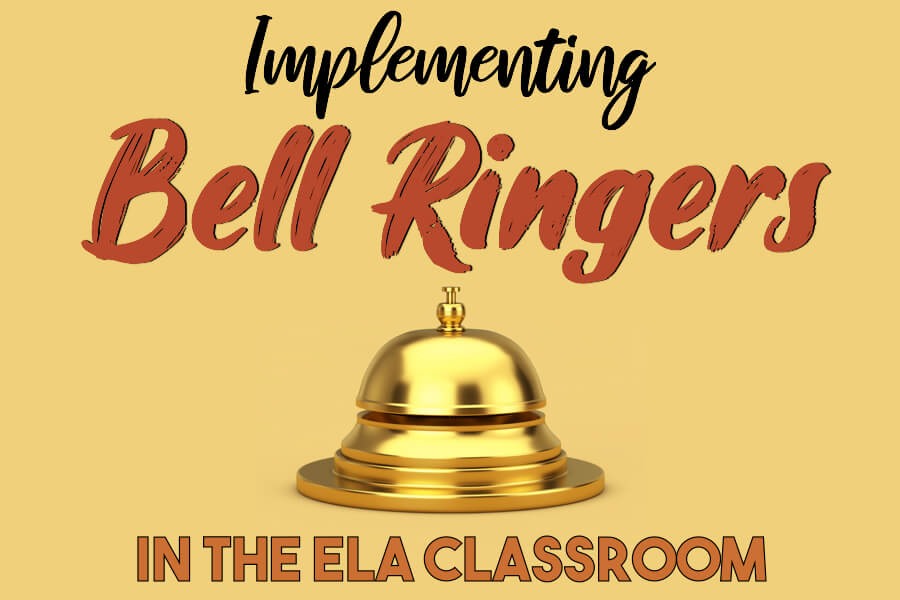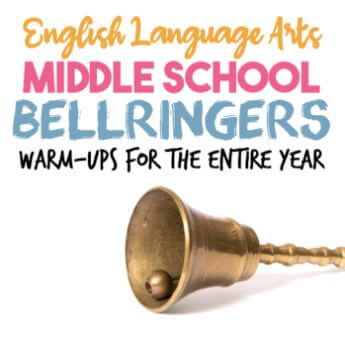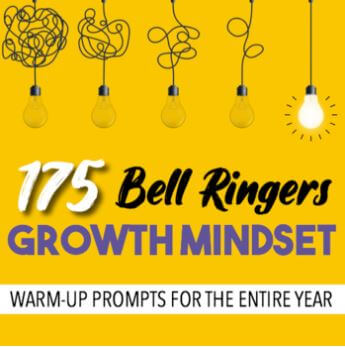Wondering about the buzz surrounding implementing bell ringers in the classroom? This post will cover everything from the whys to the hows of implementing bell ringers. Looking to get started with a few examples? You’ll find some easy-to-implement ideas in there too.
“So much to do, so little time?” Yep, that’s the battle cry of teachers everywhere. (Or is it just me?)
Some days I felt like a fish out of water or a chicken with my head cut off. Other days I was like a duck paddling fiercely underwater, just praying I didn’t drown.
Implementing bell ringers into my classroom was a total game-changer. Suddenly, my classroom had a new aura filled with more order, attention, and student-driven learning. The start-of-class stumble was replaced with a sense of reduced stress, increased structure, and overall ease for me and my students.
If you’ve been thinking about implementing bell ringers in your ELA classroom, this post can help you get started.
What is a Bell Ringer?
Bell ringers, also known as “do nows”, are small tasks or warm-up activities that students work on during the first few minutes of class. As the name suggests, bell ringers are a way to get students in their seats and focused on a meaningful task from the moment the literal (or figurative) bell rings.
Bell ringers are great for calming the start-of-class chaos we all dread. Instead of chaos, these bite-sized bits create a smooth transition as students review concepts from homework and previous lessons or preview material they will dive deeper into during class.
What are the Benefits of Implementing Bell Ringers?
If there’s one thing I’ve learned over my years of teaching is that students thrive on structure. Of course, that structure needs to be combined with student autonomy. That’s why implementing bell ringers is the perfect solution. Bell ringers encourage student autonomy by giving them an independent task to focus on at the start of class.
With that, bell ringers and the added sense of structure they create bring all sorts of benefits to the ELA classroom. While I’m sure this list is far from exhaustive, these are some of the best benefits I’ve experienced from implementing bell ringers in the ELA classroom:
- More structure and better classroom management: Students know exactly what to expect and do upon entering your classroom. This leads to less chaos and better classroom management overall.
- Set the stage (and the tone) for the day’s lesson: Whether you’re posing a thought-provoking question or introducing new terminology or text, bell ringers can pique student curiosity and preview the lesson.
- Hold students accountable for prior knowledge: Bell ringers are a great way to re-engage students with a homework assignment, previously taught material or text, or background knowledge.
- Increase student autonomy over learning: Regardless of the bell rigger, engaging students in a low-stakes self-directed task builds their confidence and strengthens their skills.
- Provide an opportunity to gather formative data with a low-stakes task: Data, data, everywhere! Bell ringers are a great way to check in on students’ understanding of a particular topic or skill.
- Buy yourself time while knowing your students are engaging in a meaningful activity: What teacher wouldn’t love the gift of time? A bell ringer buys you the time to take attendance, check your email, return graded work, pass out materials, or check-in with a student or two.
HOW LONG SHOULD A BELL RINGER BE?
There’s no rule for how long or short a bell ringer has to be. Just be sure you don’t confuse a bell ringer with a lesson or even a mini-lesson. I suggest keeping it around 5-10 minutes as they’re meant to be more of a warm-up or quick review. The exact time might vary day to day depending on what type of bell ringer you assign. If students are highly engaged in a particular bell ringer, there’s no shame in letting it go on for a few extra minutes. As long as the content adds value to your classroom, I say go for it!
Regardless, don’t let the short length of a bell ringer fool you. The impact of a good bell ringer lasts all classroom long.
SHOULD I GRADE BELL RINGERS?
ELA teachers are already burdened with plenty to grade. There’s no need to add to the pile of waiting-to-be-graded papers collecting dust on your desk. Besides, bell ringers are about structure and skills. But ultimately, when it comes to grading, it’s up to you. Grade them on completion or not at all! The choice is yours. However, if your school is breathing down your neck about collecting data, bell ringers are an easy way to check the box while providing valuable information and insights into your students’ thoughts and capabilities.
You can also consider grading some bell ringers if you’re worried about holding students accountable. For example, maybe you randomly collect a bell ringer each week for quick accountability and a small grade. It’s not enough to fail a student if they didn’t do it, but it might be just enough to keep them on task.
More Tips for Implementing Bell Ringers with Success
The possibilities are endless when it comes to bell ringers. Here are a few tips to help you implement bell ringers with success:
Change it up. While structure and consistency help students succeed, having the same bell ringer again and again can totally backfire. You don’t want to return to start-of-class chaos due to bored students and over-used bell ringers. Besides, there are plenty of options to choose from!
Set a theme. While variety is key, you can make planning easy by having themed bell ringers for each day of the week. Each theme can address a specific skill or type of bell ringer activity. Here are a few ideas for my fellow fans of alliteration:
- Monday: Mistake-Fixing Mondays or Mix-It-Up Monday (If you want wiggle room to switch it up!)
- Tuesday: Tuesday Terms or Turn-and-Talk Tuesday (bell ringers don’t always have to be independent)
Wednesday: Word-work Wednesday or Real-World Wednesday (perfect for making real-world connections!) - Thursday: Think About It Thursday or Thought Provoking Thursday (These are great springboards for classroom discussions)
- Friday Freewrite Fridays and Fix-It Friday (Everyone could use a grammar review)
Use bell ringers to activate prior knowledge. Bell ringers are a perfect opportunity for students to review important material. For example, do students remember foundational knowledge from years prior? Do they recall what was read for homework? Can they apply what was taught during the previous lesson?
Use bell ringers to prepare or preview the day’s lesson. We know time is of the essence when it comes to teaching. Bell ringers are a great way to get ahead of the game. Depending on what your lesson looks like, you can use the bell ringer to get a head start on brainstorming, make connections, prepare for discussion or debate, preview a text, or define important terms.
Set clear expectations and procedures. Make sure students know what to expect by considering: Where can they find the bell ringer? How much time do they have? Where should they complete their work? Should they turn them in? If so, where and when?
Implement a timer. If you’re tight on time, project a countdown on the board for all to see (like this timer here). Let students know there’s a lot of material to get through today, and they have X minutes to complete their bell ringer. Start the timer, and voila!
Avoid busywork. Don’t confuse bell ringers with busy work. Instead, remember that bell ringers should activate prior knowledge, practice relevant skills, or preview content related to the lesson ahead.
Example Bell Ringers for the ELA Classroom
There are so many options when it comes to bell ringers. Honestly, as long as it makes sense for your class and wouldn’t be classified as “busy work,” you’re golden! Here are a few examples you can repurpose to fit the needs of your class:
- Working on an essay? Have students review the parts of an introduction paragraph before beginning the lesson on body paragraphs. Or perhaps they can find one piece of textual evidence to incorporate into their essay.
- Having a class discussion? Have students respond to a prompt that will help them prepare and prevent the dreaded crickets during classroom discussion.
- Beginning a new novel? Present students with a short anticipation guide to get them thinking about key concepts in the text. Anticipation guides make for a great discussion starter or springboard for an end-of-novel essay.
- Another idea? Project a few inmates on the board and ask students to make inferences and predictions about the text based on what they see.
- Learning new literary devices or elements of plot? Have students identify certain elements in the chapters they read for homework or a short story from yesterday’s lesson.
More Bell Ringer Examples For the ELA Classroom
- Learning new vocabulary? Challenge students to incorporate each of the new words in a sentence. Just be sure to emphasize that the sentence should demonstrate an understanding of the word’s definition.
- Wrapping up a unit? Ask students to kick off class by writing a short reflection on what they learned and how they can apply it moving forward. Give them some guiding questions to help prevent blank stares and blank pages.
- Looking to review grammar? If you find yourself marking the same grammar mistakes over and over again in your students’ work, use a bell ringer as an opportunity to review those cornerstone grammar rules.
- Working on figurative language? There are various ways you can use bell ringers to explore and practice this literary skill. Try these three types of bell ringers: having students identify and label examples of figurative language, analyze and explain an example, or write an example of their own!
- Want to keep it literature-focused? Students can answer review questions, fill out character or plot development charts, respond to important quotes, or make predictions and connections.
And lastly…
As English teachers, our content is always a point of standardized testing. Bell ringers can be used for a daily test-prep question as well. Bonus points if you can build a connection between the test prep content or strategy to what you’ve been working on in class.
Bell Ringer Bonus: Sub Plans Made Easy
Just when you thought you knew all the perks of implementing bell ringers into your classroom…
A last-minute sick day can be a bigger headache than any actual headache is. But if you have a stash of bell-ringers planned (and once you get the hang of it, you will), there are a few ways to turn them into last-minute sub plans. String a few bell ringers together to create a multi-faceted review day.
Alternatively, expand upon a bell-ringer for a full-class lesson. It’s like a sub-plan starter pack! Maybe you were planning on doing a bite-sized grammar bit for your bell ringer. Instead of having students do 2-3 questions around grammar, turn it into a 30-minute self-directed learning experience.
You could say bell ringers are the gift that keeps on giving.
The Bottom Line with Bell Ringers
Teaching comes with enough stressors. Bell ringers are a great way to start each class with calmness over chaos. (Hallelujah!) They are a great way to get students started with a purposeful task while buying you the time to get set up for the lesson ahead. Could it buy you time to pee? Let’s not get too crazy…
Whether you use the time to pass back papers or check in with students, having these extra few minutes at the start of class makes a BIG difference. But don’t just take my word for it. Try it out for yourself! Then come back and let me know what benefits you experienced and bell ringer ideas you found success with.


